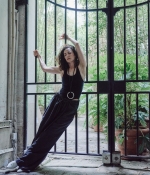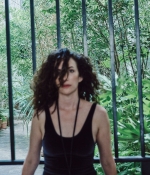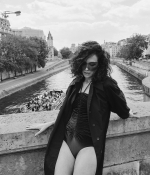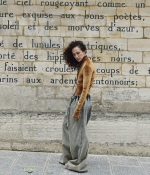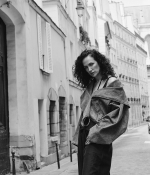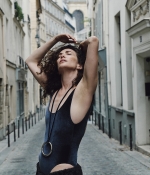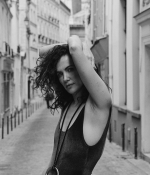The Moveable Fest – Kate & Mike Flanagan on Finding that Silence is Golden in “Hush”
At the end of “Hush,” a slightly mischievous credit comes up “introducing” the film’s star Kate Siegel, an actress who paid her dues well before her leading turn in the latest from “Oculus” director Mike Flanagan.
“It’s interesting because we were under the constraint of such a small budget, one of things we needed to offer the actor who was going to play the [other main part] was top billing,” says Siegel, who in addition to carrying the film as an actress, co-wrote it with her partner in life and film Flanagan. “There was some back and forth, but [we felt] the introducing credit is the very special, exciting credit and even though I’ve been kicking around this industry for a while, I do still feel on some levels this is my debutante debut. This is the first time they really put a movie on my shoulders and it’s the way I’d like to be introduced to the world.”
Indeed, Siegel feels like a revelation as Maddie, a writer besieged by a relentless and highly motivated masked stalker (John Gallagher Jr.) at her secluded cottage in the forest whose footsteps she cannot hear after losing her hearing at the age of 13. Though not deaf in real life, Siegel is quite convincing in the part, a brilliant character who shrewdly uses the wiles one would develop after being deprived of their sense sound to figure out how to defend herself and stay alive.
“She has to be on screen 90% of the time and carry the stretches of this movie with just her expressions,” marvels Flanagan, who knew Siegel could pull off a long-held dream of his to craft a thriller with that pesky problem of dialogue kept to a minimum. With her strong turn at the center, he’s created his most muscular film to date with a brutal game of cat-and-mouse that is constantly reinventing itself within just one location, the crossbow-wielding killer evenly matched with his prey to make their battle of wits as riveting as their physical tussles.
As if it were some perverse joke, “Hush” will be breaking into homes around the world starting today after Netflix claimed the nail biter just in advance of its celebrated premiere at SXSW last month — you can watch it right now here — and shortly before the global release, Siegel and Flanagan spoke about finding the perfect location, collaborating on the script knowing each other’s strengths and literally taking so many shots in the dark.
Was it a different experience to develop something together, knowing what you could bring to it as an actor and director, respectively?
Kate Siegel: It was my first time actually writing a script. Mike had so much more experience with that than I did, so I learned so much about the process from him, but Mike was familiar with my work and I was familiar with his work, so we could write things that we knew I would succeed at. I was able to bring so much of who I knew Maddie would be to the script level.
Did you actually know sign language beforehand?
Kate Siegel: No, I worked with an incredible coach who drilled me night and day on the signs and also helped me really understand the experience of not experiencing the wealth of someone who can hear. That was such a gift as to what kind of person Maddie is and the way she interacts with the world. Maggie is something that’s called latent deaf, which [means] she’s come to deafness late in life and creates a real sense of isolation because all of the people she was able to communicate with until her 13th birthday are no longer available to her. Her family needs to learn sign language while she does, but as she turns to the deaf community, she’s not as adept at communicating as she should be and her other senses aren’t developed, so she feels very alone in the world as a whole, not to mention what it’s like being a 13-year-old in general.
Just looking at that made perfect sense to me that a smart, independent woman would think, “I can’t get myself heard. I don’t feel understood or seen by anybody in the world. I just want to be left alone and retreat into my imagination,” so she’d decide to move into the woods and write. In the creation of her, her deafness, her muteness really lends a lot to what ends up being her strength, and by the time we were shooting, Maddie’s inner life was in my bones. I had been prepping her for nine months by the time we showed up.
Mike Flanagan: It was different [writing experience] for me because usually actors show up after you’ve done a huge amount of work, with their interpretation of the work that exists, so to create a character with an actor, knowing that this is the person that’s going to be performing the character was very unusual and because we’re writing something that doesn’t really have dialogue, that’s also a whole other way of writing. Once you remove that from the toolkit, we would spend most of our time acting out various scenarios and trying to figure [them] out realistically – like how I would try to break into her house and how Kate would try to survive an intruder. We spent way more time mostly up on our feet trying to figure it out, seeing what each of us would do and establish the dynamic we were in through trial and error than actually sitting and writing.
Kate Siegel: We blocked it in our house for the most part.
Mike Flanagan: When we got to Alabama and got into the house we’d actually be shooting in, we had to re-block and rewrite certain elements of it to fit that house. But the blocking and some of the character and emotional direction the emotional direction in the script was already present in the draft. It really was the blueprint for the technicality of the movie and Kate’s performance.
Was it an actual house you shot in in Alabama? It was so perfectly utilized I suspected it could be a set?
Kate Siegel: We got to do one more draft in the house once we ran through it. We tried to break in to [figure out] how do we utilize the particular layout of this house because we wanted it to be an intimate experience where we used the whole location, so we were [constantly] thinking, “Instead of doing X, can we do Y?”
One of the other things that’s so striking to me about this film is how much of it takes place in the dark. Were there certain rules about lighting?
Kate Siegel: Moving around in that space in the dark was all right. It was much like the sound design, when it’s actually 50 layers of sound. In order to shoot darkness, it’s actually seven or eight lights that are creating a sense of darkness and our blocking was very specific. We could work it all out with all the lights on, then we would turn the lights off and hope for the best.
What was the premiere at SXSW like?
Kate Siegel: It was amazing. Such a great audience and they’re so engaged and so intelligent. They have such great taste.
Mike Flanagan: When we got the second screening at the Alamo Drafthouse, which is such a great theater, that’s the best I’ve ever heard the movie sound. The sound system in that house is incredible. The picture was perfect. I don’t know that there will ever be a public screening as great visually and sonically as our experience at South by and Drafthouse. Those are very rare treats and the kinds of things which make a movie. You want to have that experience of a really amazing screening with a wonderful audience. We only had that once or twice. For me, that’s the screening we won’t ever forget.
Kate Siegel: It was a blast.
April 8, 2016
Source
by Stephen Saito

